Assessment of the Fragility of the Municipal Waste Sector in Serbia Using System Dynamics Modelling
Abstract
1. Introduction
2. Literature Review
3. Materials and Methods
3.1. Model for Calculation of Main Municipal Waste Indicators
3.1.1. Municipal Waste Indicators
- –
- The total municipal solid waste generated;
- –
- Separately collected municipal waste;
- –
- Municipal solid waste treated;
- –
- Recycled municipal solid waste;
- –
- The recycling rate of municipal solid waste.
Total Municipal Waste Generated
- COL_PUC(KOM1)—municipal waste collected by public utility companies on behalf of municipalities;
- COL_SEP(GIO1)—municipal waste generated by enterprises, delivered to waste collectors outside of the system of utility companies;
- COL_SEP(GIO6)—the amount of recyclable materials separated from municipal waste by the informal sector delivered to waste collectors.
Separately Collected Waste
- –
- Public utility companies (PUC) that collect recyclable waste using their infrastructure (bins, containers, communal vehicles);
- –
- Generators or waste producers (enterprises, trade, small enterprises, office buildings, and public-sector institutions) that generate waste and deliver it directly to collectors for recovery treatments;
- –
- The informal sector that separates a significant part of recyclable waste from the mass of municipal waste and delivers it mainly to waste collectors.
Municipal Waste Treated
Total Amount of Recycled Municipal Waste
3.1.2. Municipal Waste Indicators
- (a)
- by 2025, preparation for re-use and the recycling of municipal waste shall be increased to a minimum of 55% by weight;
- (b)
- by 2030, preparation for re-use and the recycling of municipal waste shall be increased to a minimum of 60% by weight;
- (c)
- by 2035, preparation for re-use and the recycling of municipal waste shall be increased to a minimum of 65% by weight.
3.2. System Dynamics Model of the Municipal Waste Sector in Serbia
4. Results
4.1. Baseline Scenario
4.2. Scenario for the Optimal Recycling Potential
4.3. Constraints and Fragility of the System
4.4. Simulating a Fragile Policy
5. Discussion
6. Conclusions
Author Contributions
Funding
Acknowledgments
Conflicts of Interest
References
- Wilson, D.C. Global waste management outlook. In International Solid Waste Association; UNEP: Nairobi, Kenya, 2015. [Google Scholar]
- Baud, I.; Grafakos, S.; Hordijk, M.; Post, J. Quality of Life and Alliances in Solid Waste Management: Contributions to urban sus-tainable development. Cities 2001, 18, 3–12. [Google Scholar] [CrossRef]
- Tamosiuniene, R.; Demianchuk, M.; Koval, V. State regulation of bankruptcy relations in the national economy. Econ. Ecol. Socium 2019, 3, 19–27. [Google Scholar] [CrossRef]
- Edomah, N. Regional Development in Africa: An Overview; IntechOpen: London, UK, 2020. [Google Scholar]
- Nnorom, I.; Osibanjo, O. Overview of electronic waste (e-waste) management practices and legislations, and their poor applications in the developing countries. Resour. Conserv. Recycl. 2008, 52, 843–858. [Google Scholar] [CrossRef]
- Yang, H.; Xia, J.; Thompson, J.R.; Flower, R.J. Urban construction and demolition waste and landfill failure in Shenzhen, China. Waste Manag. 2017, 63, 393–396. [Google Scholar] [CrossRef]
- Heidrich, O.; Harvey, J.; Tollin, N. Stakeholder analysis for industrial waste management systems. Waste Manag. 2009, 29, 965–973. [Google Scholar] [CrossRef] [PubMed]
- Chung, S.S.; Lo, C. Local waste management constraints and waste administrators in China. Waste Manag. 2008, 28, 272–281. [Google Scholar] [CrossRef] [PubMed]
- Đekić, I. Lean manufacturing in two Serbian food companies–case studies. Int. J. Qual. Res. 2012, 6, 131–136. [Google Scholar]
- Hadžistević, M.; Morača, S. Networks and Quality Improvement. Int. J. Qual. Res. 2009, 3, 353–361. [Google Scholar]
- Rother, M.; Shook, J. Learning to See: Value Stream Mapping to Add Value and Eliminate Muda; Lean Enterprise Institute: Cambridge, MA, USA, 2003. [Google Scholar]
- Dadzie, D.K.; Kaliluthin, A.K.; Kumar, D.R. Exploration of Waste Plastic Bottles Use in Construction. Civ. Eng. J. 2020, 6, 2262–2272. [Google Scholar] [CrossRef]
- Al-Hasan, S.J.A.; Balamuralikrishnan, R.; Altarawneh, M. Eco-Friendly Asphalt Approach for the Development of Sustainable Roads. J. Hum. Earth Future 2020, 1, 97–111. [Google Scholar] [CrossRef]
- Rehman, A.; Khan, K.A.; Hamid, T.; Nasir, H.; Ahmad, I.; Alam, M. Effective Utilization of Municipal Solid Waste as Substitute for Natural Resources in Cement Industry. Civ. Eng. J. 2020, 6, 238–257. [Google Scholar] [CrossRef]
- Xiao, S.; Dong, H.; Geng, Y.; Tian, X.; Liu, C.; Li, H. Policy impacts on Municipal Solid Waste management in Shanghai: A system dynamics model analysis. J. Clean. Prod. 2020, 262, 121366. [Google Scholar] [CrossRef]
- Sukholthaman, P.; Sharp, A. A system dynamics model to evaluate effects of source separation of municipal solid waste management: A case of Bangkok, Thailand. Waste Manag. 2016, 52, 50–61. [Google Scholar] [CrossRef] [PubMed]
- Watson, K.J.; Blackstone, J.H.; Gardiner, S.C. The evolution of a management philosophy: The theory of constraints. J. Oper. Manag. 2006, 25, 387–402. [Google Scholar] [CrossRef]
- Mabin, V.J.; Balderstone, S.J. The performance of the theory of constraints methodology: Analysis and discussion of successful TOC applications. Int. J. Oper. Prod. Manag. 2003, 23, 568–595. [Google Scholar] [CrossRef]
- Mabin, V.J.; Balderstone, S.J. The World of the Theory of Constraints: A Review of the International Literature; CRC Press: Boca Raton, FL, USA, 2020. [Google Scholar] [CrossRef]
- Forrester, J.W. System dynamics—The next fifty years. Syst. Dyn. Rev. J. Syst. Dyn. Soc. 2007, 23, 359–370. [Google Scholar] [CrossRef]
- Sterman, J. Business Dynamics: Systems thinking and modeling for a complex world. In MIT Sloan School of Management; Working Paper Series; Massachusetts Institute of Technology: Cambridge, MA, USA, 2000. [Google Scholar]
- Lyneis, J.M.; Ford, D.N. System dynamics applied to project management: A survey, assessment, and directions for future research. Syst. Dyn. Theory Appl. 2007, 23, 157–189. [Google Scholar] [CrossRef]
- Jovičić, M.; Mačuzić, I.; Vukićević, A.; Demichela, M. Stress testing with system dynamics for enterprises: Proposing a new risk approach for the transition to circular economy and sustainable development. Recycl. Sustain. Dev. 2019, 12, 13–23. [Google Scholar] [CrossRef]
- Makridakis, S. If we cannot forecast how can we plan? Long Range Plan. 1981, 14, 10–20. [Google Scholar] [CrossRef]
- Makridakis, S. Chronology of the last six recessions. Omega 1982, 10, 43–50. [Google Scholar] [CrossRef]
- Makridakis, S.; Taleb, N. Living in a world of low levels of predictability. Int. J. Forecast. 2009, 25, 840–844. [Google Scholar] [CrossRef]
- Veeramachaneni, K. Why you’re not getting value from your data science. Harv. Bus. Rev. 2016, 7. Available online: https://hbr.org/2016/12/why-youre-not-getting-value-from-your-data-science (accessed on 30 October 2021).
- Nicholas Taleb, N. The black swan: The impact of the highly improbable. Victoria 2015, 250, 595–7955. [Google Scholar]
- Aven, T. On the meaning of a black swan in a risk context. Saf. Sci. 2013, 57, 44–51. [Google Scholar] [CrossRef]
- Anderson, S.C.; Branch, T.A.; Cooper, A.B.; Dulvy, N.K. Black-swan events in animal populations. Proc. Natl. Acad. Sci. USA 2017, 114, 3252–3257. [Google Scholar] [CrossRef] [PubMed]
- Murphy, J.F.; Conner, J. Beware of the black swan: The limitations of risk analysis for predicting the extreme impact of rare process safety incidents. Process. Saf. Prog. 2012, 31, 330–333. [Google Scholar] [CrossRef]
- Taylor, J.B.; Williams, J.C. A Black Swan in the Money Market. Am. Econ. J. Macroecon. 2009, 1, 58–83. [Google Scholar] [CrossRef]
- Hajikazemi, S.; Ekambaram, A.; Andersen, B.; Zidane, Y.J. A Black Swan–Knowing the unknown in projects. Procedia-Soc. Behav. Sci. 2016, 226, 184–192. [Google Scholar] [CrossRef]
- Vacante, M.; D’Agata, V.; Motta, M.; Malaguarnera, G.; Biondi, A.; Basile, F.; Malaguarnera, M.; Gagliano, C.; Drago, F.; Salamone, S. Centenarians and supercentenarians: A black swan. Emerging social, medical and surgical problems. BMC Surg. 2012, 12, S36–S36. [Google Scholar] [CrossRef]
- Hubbard, G. Measuring organizational performance: Beyond the triple bottom line. Bus. Strat. Environ. 2006, 18, 177–191. [Google Scholar] [CrossRef]
- Jovičić, M.; Mačužić, I.; Vukićević, A.; Demichela, M. Enterprise stress testing with system dynamics: A state of research and challenges. Proc. Eng. Sci. 2019, 1, 65–72. [Google Scholar] [CrossRef]
- Taleb, N.N. Antifragile: Things That Gain from Disorder; Random House Incorporated: New York, NY, USA, 2012; Volume 3. [Google Scholar]
- Taleb, N.N.; Read, R.; Douady, R.; Norman, J.; Bar-Yam, Y. The precautionary principle (with application to the genetic modification of organisms). arXiv 2014, arXiv:1410.5787. [Google Scholar]
- Clancy, T.R. Control: What we can learn from complex systems science. JONA J. Nurs. Adm. 2008, 38, 272–274. [Google Scholar] [CrossRef]
- Größler, A. A managerial operationalization of antifragility and its consequences in supply chains. Syst. Res. Behav. Sci. 2020, 37, 896–905. [Google Scholar] [CrossRef]
- Jovicic, N.; Boskovic, G. Indicators for Municipal and Packaging Waste for 2018–2020 according to Eurostat Requirements. Report-ENVAP 3, Environmental Accession Project; WP-Further Development of waste Indicators for Reporting on Waste Framework and Packaging and Packaging Waste DSIP Targets; 2021; in press. [Google Scholar]
- Directive 2008/98/EC of the European Parliament and of the Council of 19 November 2008 on Waste and Repealing Certain Directives; Amended by Directive (EU) 2018/851 of the European Parliament and of the Council of 30 May 2018. Available online: https://eur-lex.europa.eu/legal-content/EN/TXT/?uri=uriserv:OJ.L_.2018.150.01.0109.01.ENG (accessed on 10 October 2021).
- Rulebook on Daily Records and Annual Report on Waste with Guidance on Filing in; Official Gazette of Republic of RS: Beograd, Serbia, 2021; p. 79. (In Serbian)
- Guidance for the Compilation and Reporting of Data on Municipal Waste according to Commission Implementing Decisions 2019/1004/EC and 2019/1885/EC, and the Joint Questionnaire of Eurostat and OECD. Directorate E: Sectoral and Regional Statistics Unit E-2: Environmental Statistics and Accounts; Sustainable Development; 2021. Available online: https://ec.europa.eu/eurostat/documents/342366/351811/Guidance+on+municipal+waste+data+collection/ (accessed on 12 October 2021).
- Commission Implementing Decision (EU) 2019/1004 of 7 June 2019 Laying down Rules for the Calculation, Verification and Reporting of Data on Waste in Accordance with Directive 2008/98/EC of the European Parliament and of the Council and re-pealing Commission Implementing Decision C (2012) 2384; 2019. Available online: https://eur-lex.europa.eu/eli/dec_impl/2019/1004/oj (accessed on 12 October 2021).
- Commission Decision2011/753/EU of 18 November 2011 Establishing Rules and Calculation Methods for Verifying Compliance with the Targets set in Article 11(2) of Directive 2008/98/EC of the European Parliament and of the Council; 2011. Available online: https://eur-lex.europa.eu/legal-content/EN/TXT/?uri=CELEX%3A32011D0753 (accessed on 12 October 2021).
- Annual Report on the State of the Environment in the Republic of Serbia for 2020; Serbian Environmental Protection Agency: Beograd, Serbia, 2020. (In Serbian)
- Eurostat. Municipal Waste Statistics—Statistics Explained. Available online: https://ec.europa.eu/eurostat/statistics-explained/index.php?title=Municipal_waste_statistics (accessed on 10 November 2019).
- World Bank. Serbia’s New Growth Agenda; World Bank: Washington, DC, USA, 2019. [Google Scholar]
- Statistical Office of the Republic of Serbia. Estimated Number of Population in the Republic of Serbia. 2020. Available online: https://www.stat.gov.rs/en-US/vesti/20210701-procenjen-broj-stanovnika-2020/?s=1801 (accessed on 2 November 2021).
- Williams, R.; Irati, A.; Andreea, B.; Graeme, N. Emerging Challenges of Waste Management in Europe-Limits of Recycling [Internet]; European Environment Agency (EEA): København, Denmark, 2020. [Google Scholar]
- Van der Linden, A. Scenarios for Municipal Waste Recycling Based on the European Reference Model on Municipal Waste—A Contribution to the First Early Warning Report [Internet]; The European Environment Agency: København, Denmark, 2018. [Google Scholar]
- Study to Support the Implementation of Reporting Obligations Resulting from the New Waste Legislation Adopted in 2018. Eunomia Research & Consulting. 2018. Available online: https://op.europa.eu/en/publication-detail/-/publication/3d72ef00-bcac-11e9-9d01-01aa75ed71a1 (accessed on 12 October 2021).
- Gupta, M.C.; Boyd, L.H. Theory of constraints: A theory for operations management. Int. J. Oper. Prod. Manag. 2008, 28, 991–1012. [Google Scholar] [CrossRef]
- Taleb, N.N.; Douady, R. A Map and Simple Heuristic to Detect Fragility, Antifragility, and Model Error; NYU-Poly Working Paper; SSRN: Amsterdam, The Netherlands, 2011. [Google Scholar] [CrossRef]
- Taleb, M.N.; Canetti, M.E.; Kinda, M.T.; Loukoianova, M.E.; Schmieder, M.C. A New Heuristic Measure of Fragility and Tail Risks: Application to Stress Testing; International Monetary Fund: Washington, DC, USA, 2012. [Google Scholar] [CrossRef]
- De Bruijn, H.; Größler, A.; Videira, N. Antifragility as a design criterion for modelling dynamic systems. Syst. Res. Behav. Sci. 2019, 37, 23–37. [Google Scholar] [CrossRef]
- Feng, L.-H.; Zhang, X.-C.; Luo, G.-Y. Application of system dynamics in analyzing the carrying capacity of water resources in Yiwu City, China. Math. Comput. Simul. 2008, 79, 269–278. [Google Scholar] [CrossRef]
- De Paula, A.; Scheinkman, J.A. The Informal Sector; National Bureau of Economic Research Cambridge: Cambridge, MA, USA, 2007. [Google Scholar]
- Rauch, J.E. Modelling the informal sector formally. J. Dev. Econ. 1991, 35, 33–47. [Google Scholar] [CrossRef]
- Amaral, P.S.; Quintin, E. A competitive model of the informal sector. J. Monetary Econ. 2006, 53, 1541–1553. [Google Scholar] [CrossRef]
- Krstić, G.; Schneider, F. Formalizing the Shadow Economy in Serbia: Policy Measures and Growth Effects; Springer: Berlin/Heidelberg, Germany, 2015. [Google Scholar]
- Kogan, I. When informal is normal. On the role of credentials and contacts for the job entry in Serbia. Res. Soc. Strat. Mobil. 2011, 29, 445–458. [Google Scholar] [CrossRef]
- Blunch, N.-H. Bound to lose, bound to win? The financial crisis and the informal-formal sector earnings gap in Serbia. IZA J. Labor Dev. 2015, 4, 317. [Google Scholar] [CrossRef][Green Version]
- Massarutto, A. Municipal waste management as a local utility: Options for competition in an environmentally-regulated industry. Util. Policy 2007, 15, 9–19. [Google Scholar] [CrossRef]
- Bel, G.; Warner, M. Does privatization of solid waste and water services reduce costs? A review of empirical studies. Resour. Conserv. Recycl. 2008, 52, 1337–1348. [Google Scholar] [CrossRef]
- Minakova, I.; Bukreeva, B.T.; Timofeeva, O. Improvement of solid waste management: Organizational and technological aspects. J. Appl. Eng. Sci. 2018, 16, 99–103. [Google Scholar] [CrossRef]
- Katusiimeh, M.W.; Burger, K.; Mol, A.P. Informal waste collection and its co-existence with the formal waste sector: The case of Kampala, Uganda. Habitat Int. 2012, 38, 1–9. [Google Scholar] [CrossRef]
- Ezeah, C.; Fazakerley, J.A.; Roberts, C.L. Emerging trends in informal sector recycling in developing and transition countries. Waste Manag. 2013, 33, 2509–2519. [Google Scholar] [CrossRef]
- Medina, M. The world’s scavengers: Salvaging for sustainable consumption and production. In Globalization and the Environment; AltaMira Press: Lanham, MD, USA, 2007. [Google Scholar]
- Zia, H.; Devadas, V.; Shukla, S. Assessing informal waste recycling in Kanpur City, India. Manag. Environ. Qual. Int. J. 2008, 19, 597–612. [Google Scholar] [CrossRef]
- Goldstein, J. A Pyrrhic Victory? The Limits to the Successful Crackdown on Informal-Sector Plastics Recycling in Wenan County, China. Mod. China 2016, 43, 3–35. [Google Scholar] [CrossRef]
- Medina, M. The informal recycling sector in developing countries: Organizing waste pickers to enhance their impact. In Gridlines; No. 44; World Bank: Washington, DC, USA, 2008. [Google Scholar]
- Chi, X.; Wang, M.; Reuter, M. E-waste collection channels and household recycling behaviors in Taizhou of China. J. Clean. Prod. 2014, 80, 87–95. [Google Scholar] [CrossRef]
- Prasad, K.D.; Murthy, P.K.; Gireesh, C.H.; Prasad, M.; Sravani, K. Prioritization of e-waste management strategies towards green computing using AHP-QFD approach. Proc. Eng. 2021, 3, 33–40. [Google Scholar] [CrossRef]
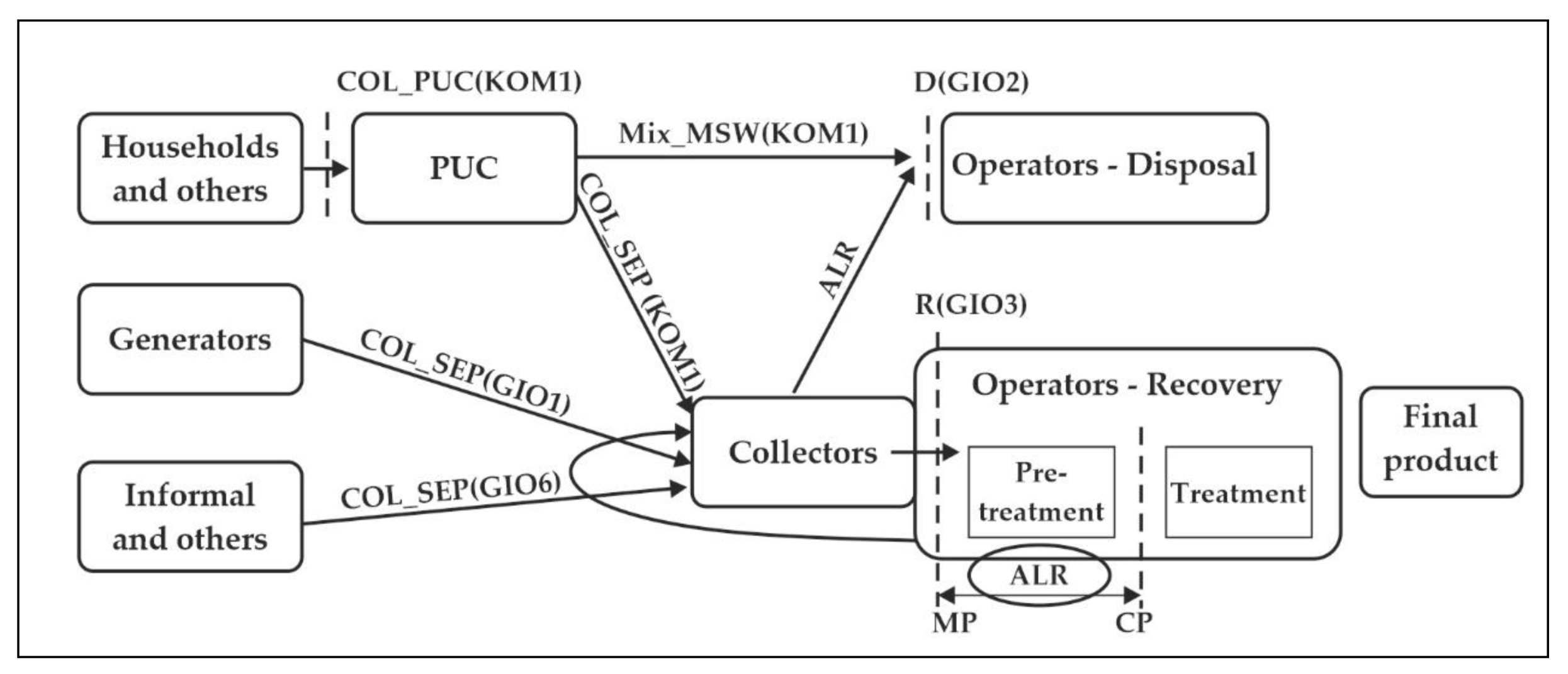
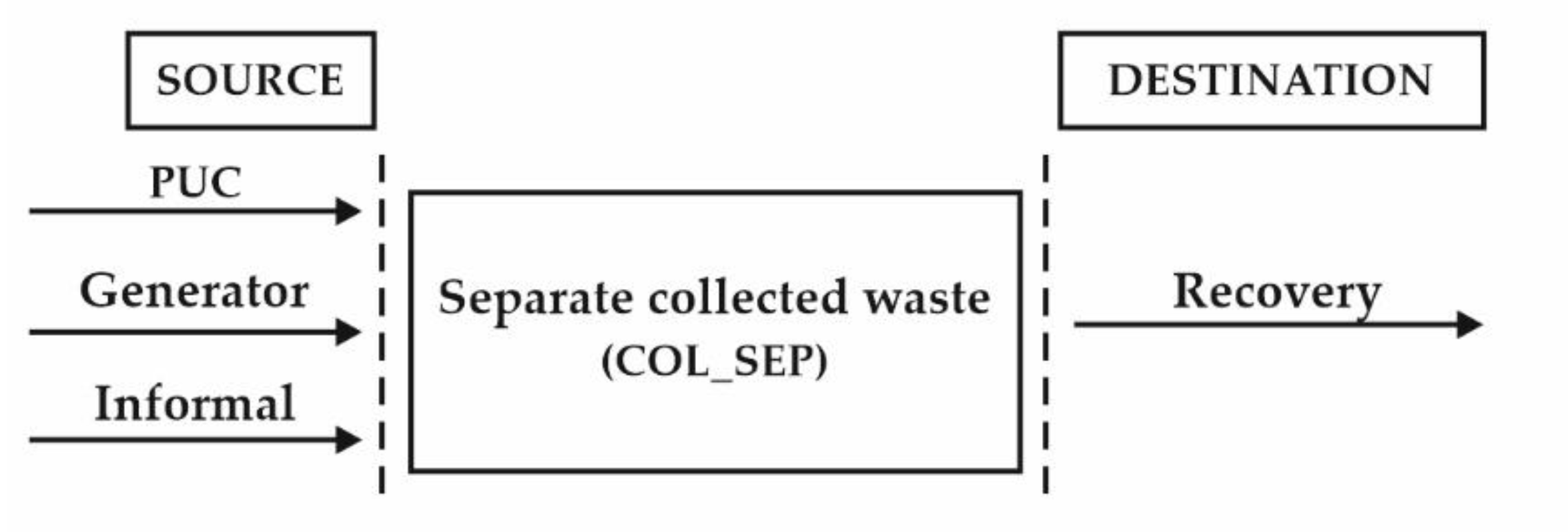
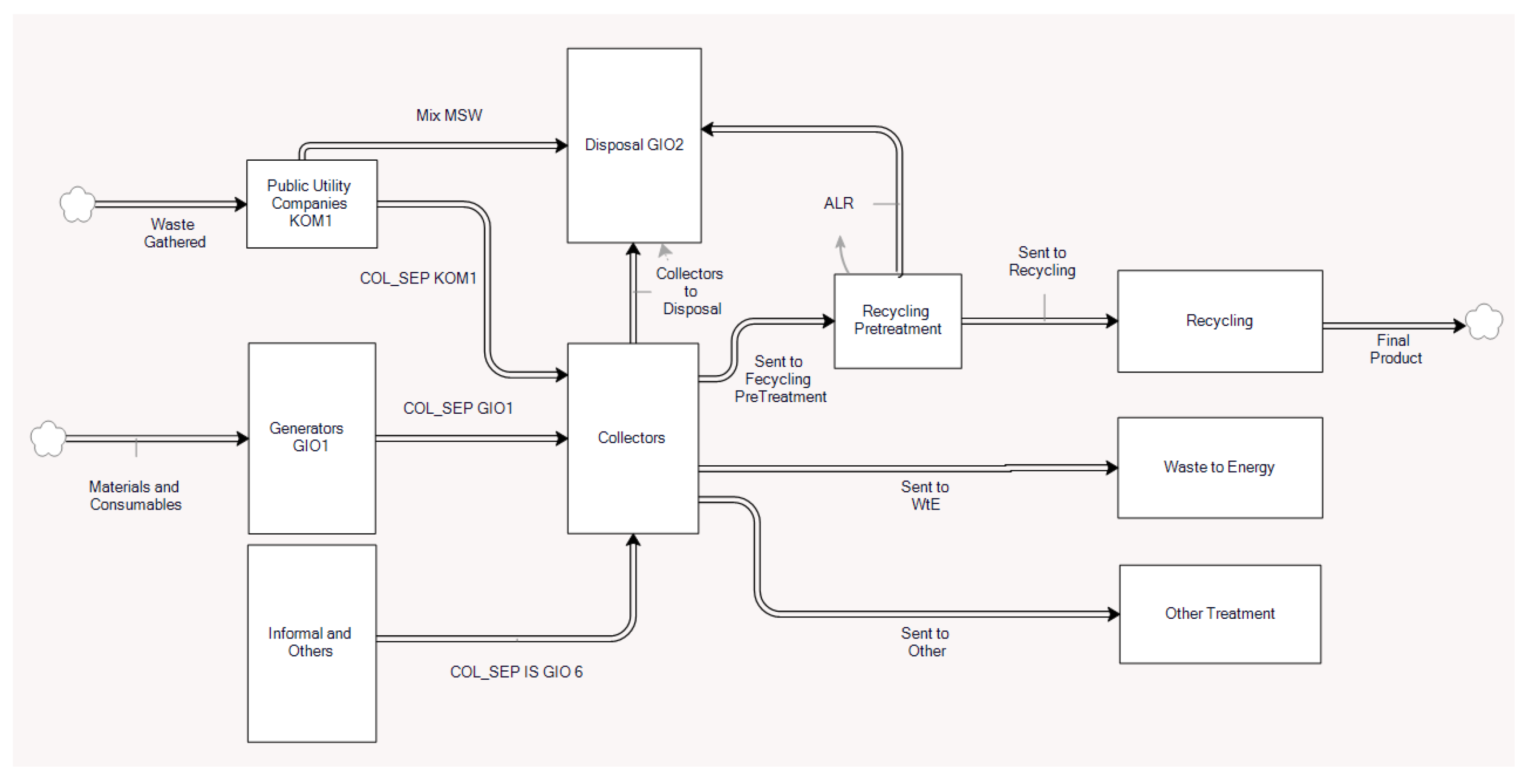
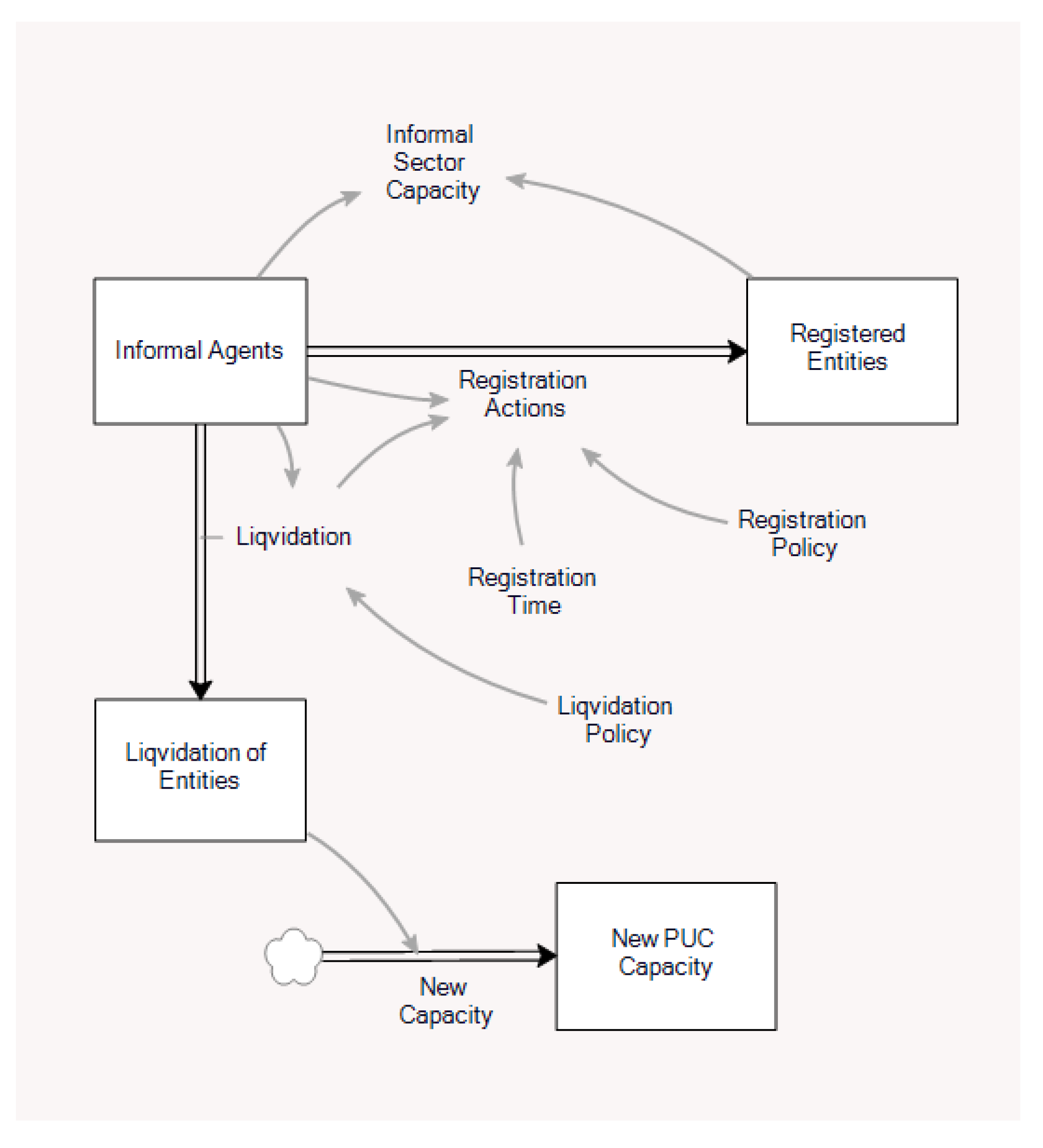
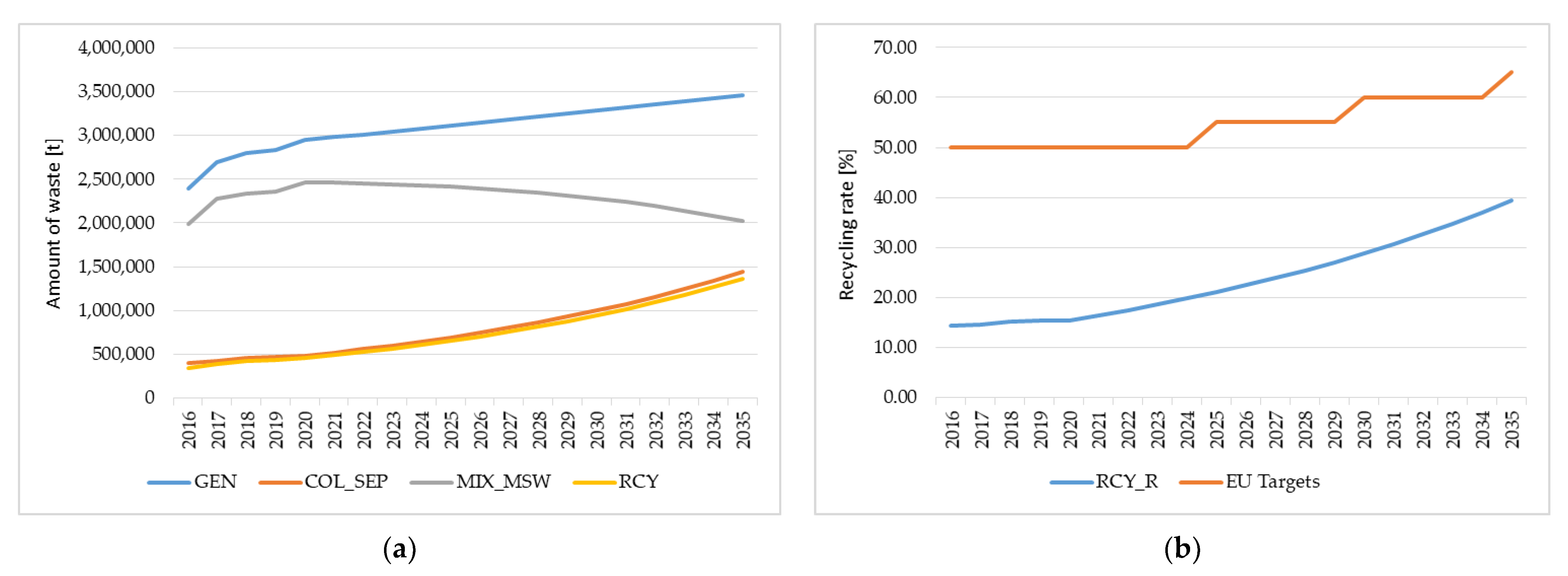
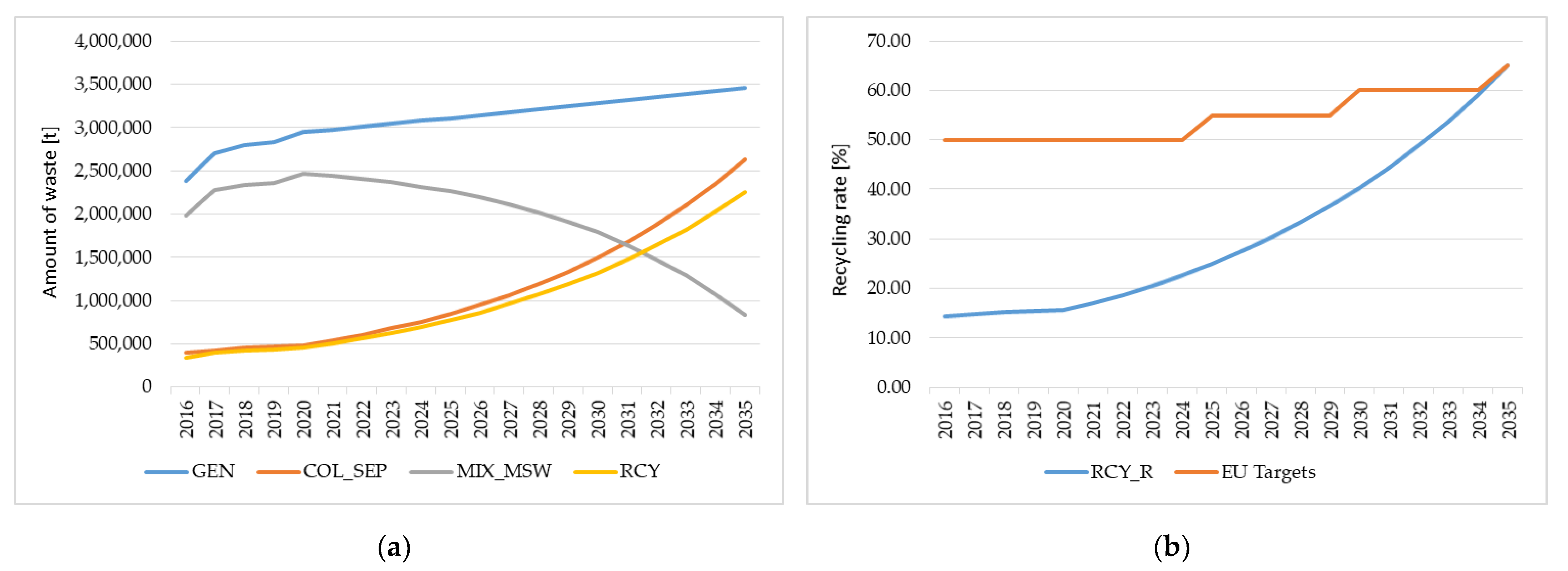
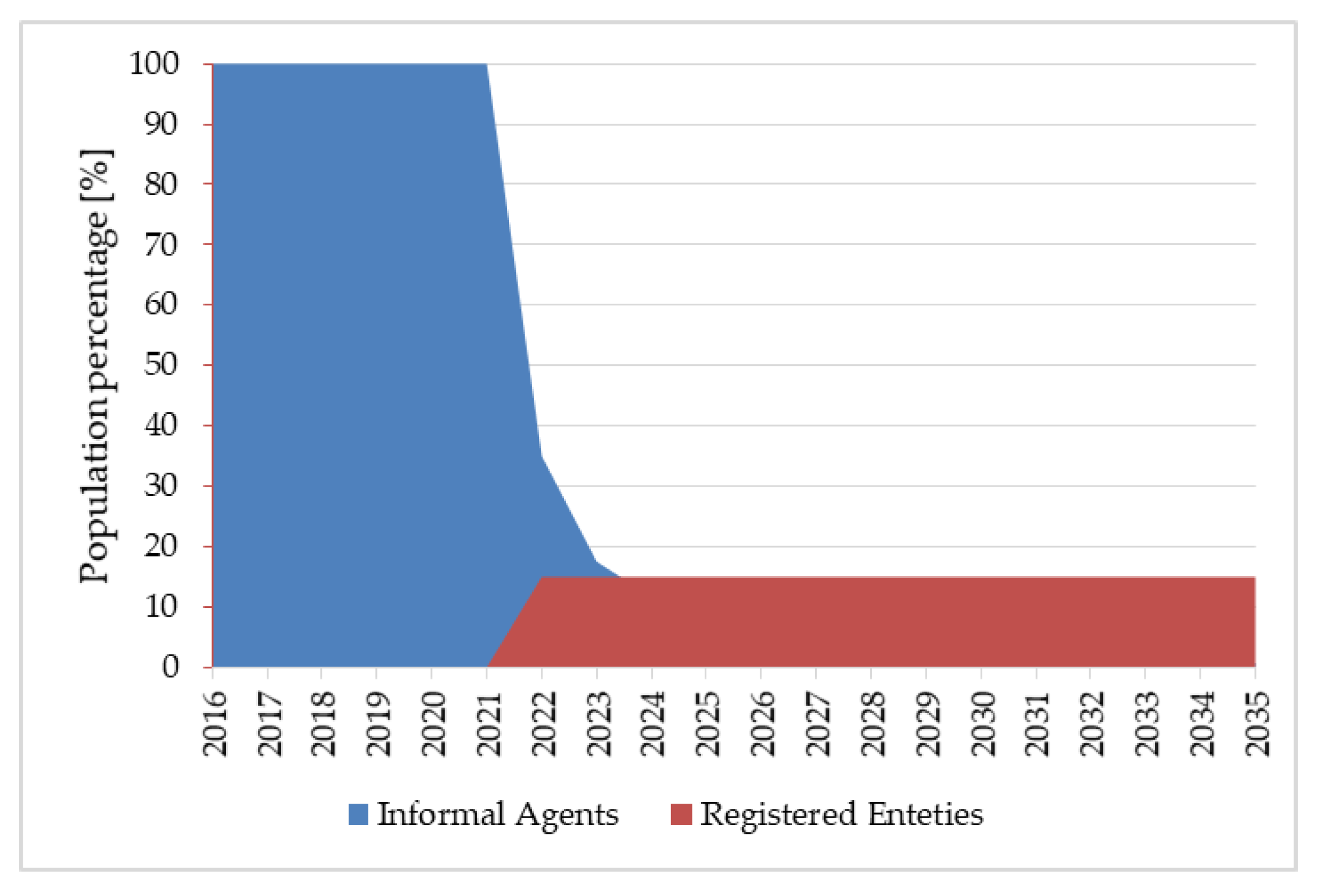
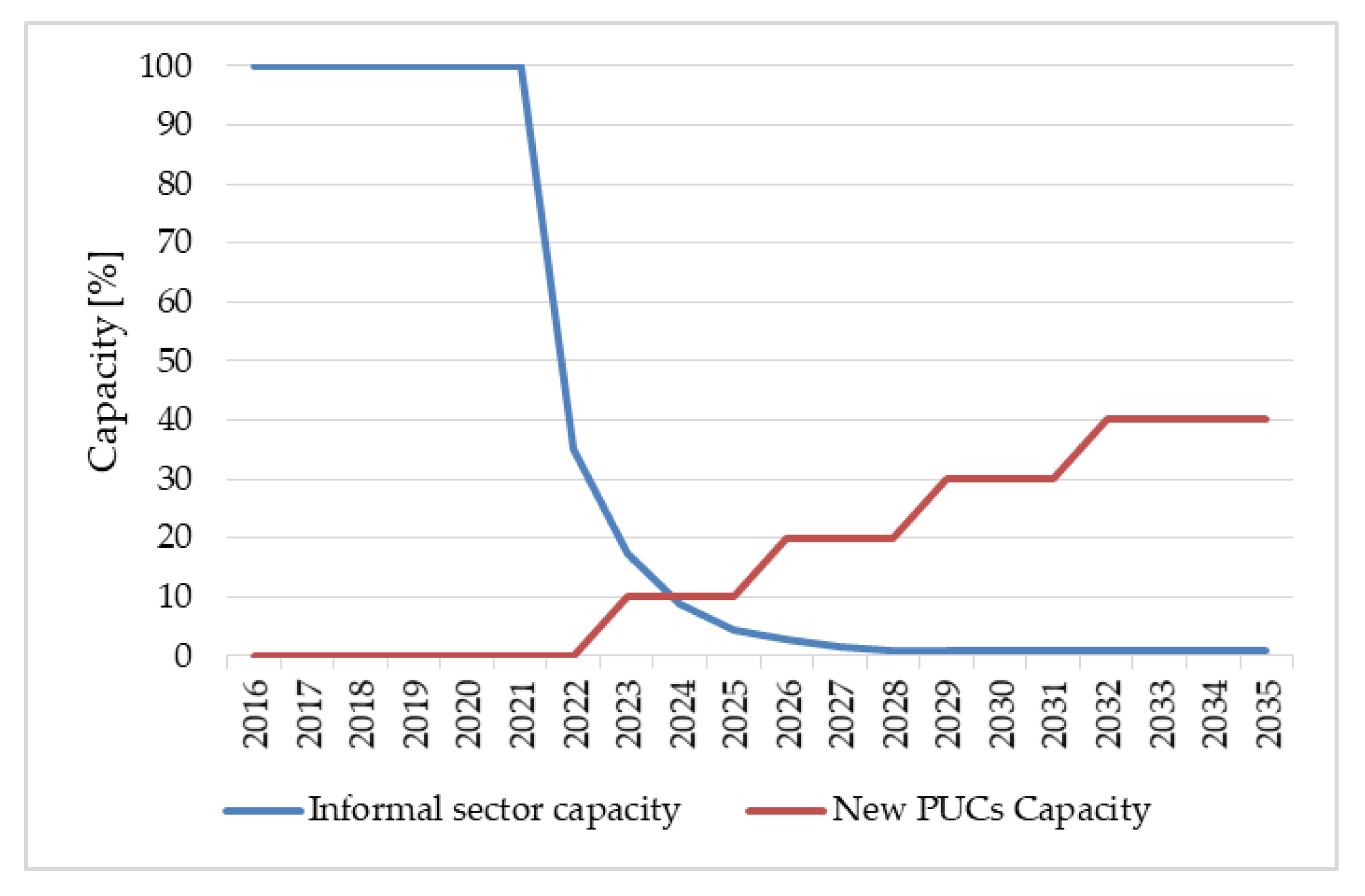
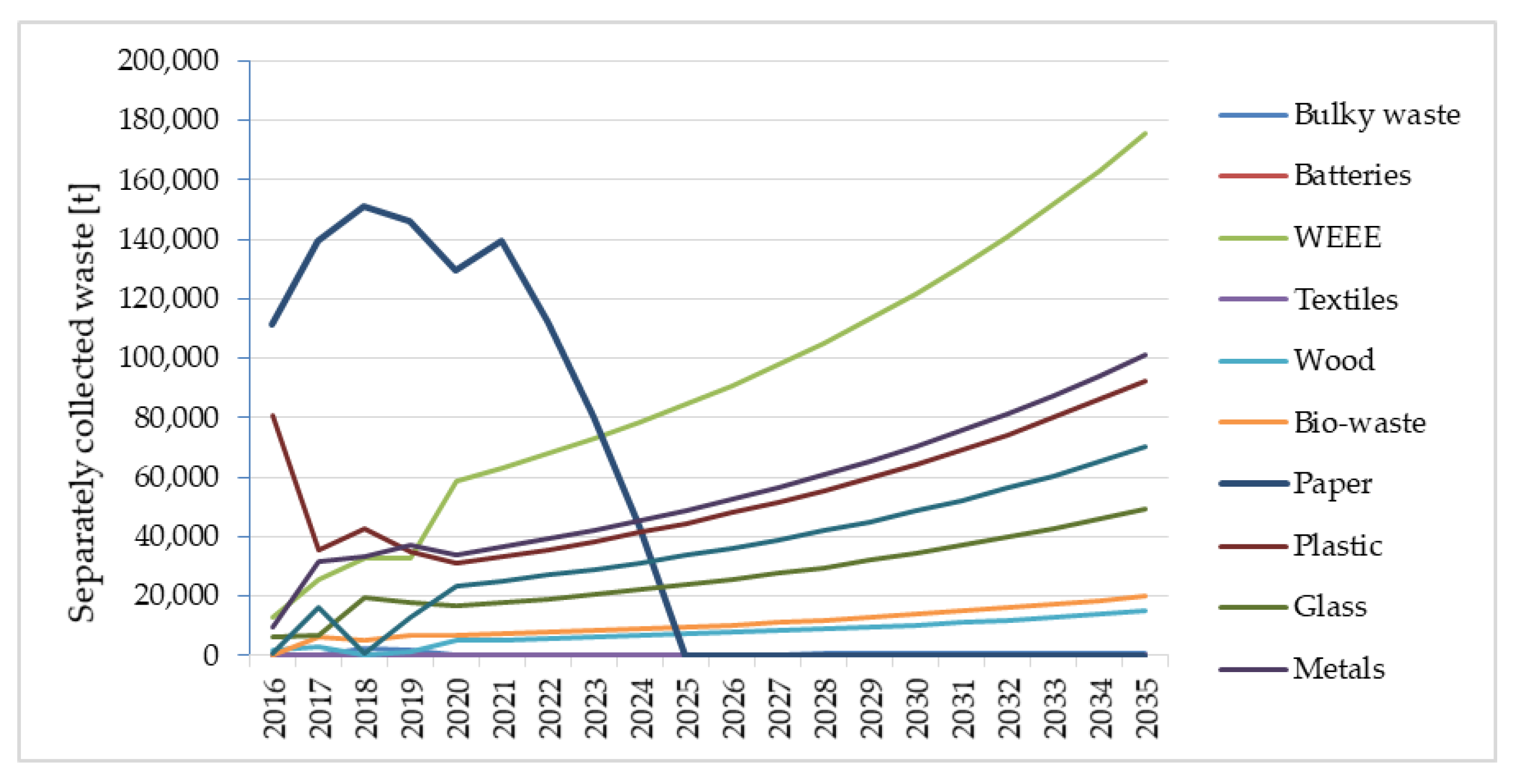
| Waste Fraction | Share (%) | Mix_MSW (t) | COL_SEP (t) | GEN (t) |
|---|---|---|---|---|
| Metals | 4.3 | 105,994 | 47,853 | 153,848 |
| Glass | 4 | 98,599 | 22,238 | 120,838 |
| Plastic | 12.2 | 300,728 | 55,293 | 356,021 |
| Paper and cardboard | 6.2 | 152,829 | 229,973 | 382,802 |
| Bio-waste | 47.4 | 1,168,401 | 11,469 | 1,179,870 |
| Wood | 2.9 | 71,484 | 27,945 | 99,429 |
| Textiles | 3.3 | 81,344 | 61 | 81,405 |
| WEEE | 4.3 | 105,994 | 60,704 | 166,698 |
| Batteries | 0.002 | 49 | 21 | 70 |
| Bulky waste | 0.038 | 937 | 422 | 1359 |
| Mixed waste | 14.4 | 354,957 | 0 | 354,957 |
| Other | 0.96 | 23,664 | 26,536 | 50,199 |
| Total | 100 | 2,464,981 | 482,515 | 2,947,496 |
| Variable Name | 2016 | 2017 | 2018 | 2019 | 2020 |
|---|---|---|---|---|---|
| MSW_MIX(KOM1) | 1,984,500 | 2,275,000 | 2,340,909 | 2,361,748 | 2,464,981 |
| COL_SEP(KOM1) | 13,024 | 17,092 | 5989 | 5808 | 16,731 |
| COL_SEP(GIO1) | 133,813 | 140,708 | 160,459 | 168,569 | 160,785 |
| COL_SEP(GIO6) | 224,834 | 265,057 | 287,940 | 291,784 | 305,000 |
| Waste Indicator | 2016 | 2017 | 2018 | 2019 | 2020 |
|---|---|---|---|---|---|
| Municipal waste generated (t) | GEN = COL_PUC(KOM1) + COL_SEP(GIO1) + COL_SEP(GIO6) | ||||
| 2,356,171 | 2,697,857 | 2,795,296 | 2,827,910 | 2,947,497 | |
| Separately collected waste (t) | COL_SEP = COL_SEP(KOM1) + COL_SEP(GIO1) + COL_SEP(GIO6) | ||||
| 371,671 | 422,857 | 454,387 | 466,162 | 482,515 | |
| Recycled waste (t) | RCY = RCV (R3, R4, R5) | ||||
| 341,345 | 394,863 | 421,826 | 435,233 | 455,457 | |
| Energy recovery (t) | RCV_E = RCV (R1) | ||||
| 2911 | 3224 | 3861 | 6689 | 5860 | |
| Other treatments (t) | RCV_OTH = RCV (Other) | ||||
| 23,546 | 20,465 | 24,425 | 19,818 | 16,580 | |
| Recycling rate (%) | RCY_R = RCV (R3, R4, R5)/GEN | ||||
| 14.49 | 14.64 | 15.09 | 15.39 | 15.45 | |
| Waste Indicator | 2020 | 2025 | 2030 | 2035 |
|---|---|---|---|---|
| Municipal waste generated (t) | 2,947,496 | 3,110,136 | 3,281,751 | 3,462,835 |
| Municipal waste generated per capita (kg/cap) | 427 | 451 | 476 | 502 |
| Separately collected waste (t) | 482,515 | 695,294 | 1,001,905 | 1,443,724 |
| Collected mixed municipal waste (t) | 2,464,981 | 2,414,842 | 2,279,846 | 2,019,111 |
| Recycled waste (t) | 455,457 | 656,304 | 945,720 | 1,362,764 |
| Recycling rate (%) | 15.45 | 21.10 | 28.82 | 39.35 |
| Waste Fraction | GEN 2035 (t) | Max_SEP (%) | COL_SEP 2035 (t) | Growth Rate (% per Year) |
|---|---|---|---|---|
| Metals | 180,746 | 96 | 173,516 | 8.97 |
| Glass | 141,965 | 77 | 109,313 | 11.20 |
| Plastic | 418,268 | 70 | 292,787 | 11.75 |
| Paper and cardboard | 449,731 | 96 | 431,742 | 4.29 |
| Bio-waste | 1,386,157 | 95 | 1,316,849 | 37.20 |
| Wood | 116,814 | 43 | 50,230 | 3.99 |
| Textiles | 95,638 | 74 | 70,772 | 60.15 |
| WEEE | 195,844 | 75 | 146,883 | 6.07 |
| Batteries | 82 | 100 | 82 | 9.68 |
| Bulky waste | 1597 | 75 | 1197 | 7.20 |
| Mixed waste | 417,018 | 0 | 0 | 0.00 |
| Other | 58,976 | 60 | 35,386 | 1.94 |
| Total | 3,462,835 | 2,628,758 |
| Waste Fraction | GEN 2035 (t) | COL_SEP2035 (t) | ALR (%) | RCY 2035 (t) | RCY_R 2035 (%) |
|---|---|---|---|---|---|
| Metals | 180,746 | 173,516 | 2 | 170,046 | 94.08 |
| Glass | 141,965 | 109,313 | 6 | 102,754 | 72.38 |
| Plastic | 418,268 | 292,787 | 25 | 219,591 | 52.5 |
| Paper and cardboard | 449,731 | 431,742 | 15 | 366,980 | 81.6 |
| Bio-waste | 1,386,157 | 1,316,849 | 15 | 1,119,322 | 80.75 |
| Wood | 116,814 | 50,230 | 7 | 46,714 | 39.99 |
| Textiles | 95,638 | 70,772 | 9 | 64,402 | 67.34 |
| WEEE | 195,844 | 146,883 | 12 | 129,257 | 66 |
| Batteries | 82 | 82 | 15 | 70 | 85 |
| Bulky waste | 1597 | 1197 | 7 | 1114 | 69.75 |
| Mixed waste | 417,018 | 0 | 0 | 0 | 0 |
| Other | 58,976 | 35,386 | 7 | 32,909 | 55.8 |
| Total | 3,462,835 | 2,628,758 | 2,253,158 | 65.07 |
| Waste Indicator | 2020 | 2025 | 2030 | 2035 |
|---|---|---|---|---|
| Municipal waste generated (t) | 2,947,496 | 3,110,136 | 3,281,751 | 3,462,835 |
| Municipal waste generated per capita (kg/cap) | 427 | 451 | 476 | 502 |
| Separately collected waste (t) | 482,515 | 849,070 | 1,494,089 | 2,628,758 |
| Collected mixed municipal waste (t) | 2,464,981 | 2,261,066 | 1,787,662 | 834,077 |
| Recycled waste (t) | 455,457 | 775,090 | 1,319,036 | 2,253,158 |
| Recycling rate (%) | 15.45 | 24.92 | 40.19 | 65.07 |
| Waste Indicator | 2020 | 2025 | 2030 | 2035 |
|---|---|---|---|---|
| Separately collected waste (t) | 482,515 | 849,032 | 1,493,954 | 2,628,758 |
| -Public/private utility companies (t) | 16,731 | 29,440 | 51,802 | 91,151 |
| -Informal sector (t) | 305,000 | 536,676 | 944,334 | 1,661,647 |
| -Generators (t) | 160,784 | 282,917 | 497,819 | 875,961 |
Publisher’s Note: MDPI stays neutral with regard to jurisdictional claims in published maps and institutional affiliations. |
© 2022 by the authors. Licensee MDPI, Basel, Switzerland. This article is an open access article distributed under the terms and conditions of the Creative Commons Attribution (CC BY) license (https://creativecommons.org/licenses/by/4.0/).
Share and Cite
Jovičić, M.; Bošković, G.B.; Jovičić, N.; Savković, M.; Mačužić, I.; Stefanović, M.; Klochkov, Y. Assessment of the Fragility of the Municipal Waste Sector in Serbia Using System Dynamics Modelling. Sustainability 2022, 14, 862. https://doi.org/10.3390/su14020862
Jovičić M, Bošković GB, Jovičić N, Savković M, Mačužić I, Stefanović M, Klochkov Y. Assessment of the Fragility of the Municipal Waste Sector in Serbia Using System Dynamics Modelling. Sustainability. 2022; 14(2):862. https://doi.org/10.3390/su14020862
Chicago/Turabian StyleJovičić, Miloš, Goran B. Bošković, Nebojša Jovičić, Marija Savković, Ivan Mačužić, Miladin Stefanović, and Yury Klochkov. 2022. "Assessment of the Fragility of the Municipal Waste Sector in Serbia Using System Dynamics Modelling" Sustainability 14, no. 2: 862. https://doi.org/10.3390/su14020862
APA StyleJovičić, M., Bošković, G. B., Jovičić, N., Savković, M., Mačužić, I., Stefanović, M., & Klochkov, Y. (2022). Assessment of the Fragility of the Municipal Waste Sector in Serbia Using System Dynamics Modelling. Sustainability, 14(2), 862. https://doi.org/10.3390/su14020862








